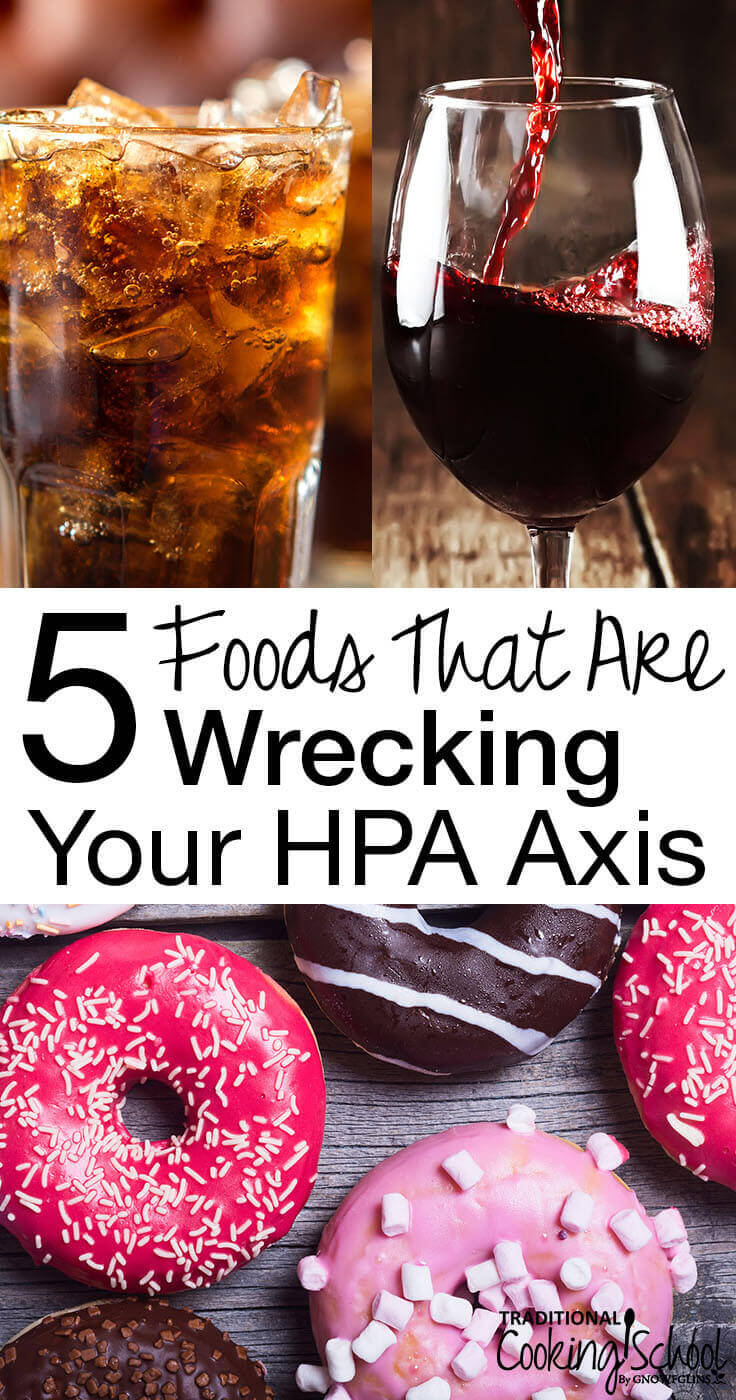
Depending on the source, it is estimated that between 66% and 80% of Americans report suffering from adrenal fatigue or have symptoms pointing to it.
Let that sink in for a moment…
Over half — perhaps over three-fourths — of our population is living with so much stress, trauma, and busyness that they’re experiencing symptoms ranging from inconvenient to annoying to downright debilitating.
What sort of symptoms?
- insomnia
- weight gain, especially in the mid-section
- brain fog
- thyroid dysfunction
- depression and/or anxiety
- hypoglycemia and other blood sugar problems
- all-day fatigue, particularly in the morning and mid-afternoon
- cravings for salt or salty foods
- depressed immune system/recurrent illnesses or infections
- dizziness when standing (orthostatic hypotension)
- blood pressure issues
- inflammation
- rise in allergies — food, chemical, or environmental
- low libido
- poor muscle tone or loss of muscle mass
- dry skin
- slow wound healing
- constipation
- inability to concentrate and focus
- memory problems — can’t remember why you walked into a room or where your car keys are
- cold hands and feet
However, in recent years, the term “adrenal fatigue” has been found to lack sufficient explanation for the range of symptoms and rollercoaster of hormones that occurs. Therefore, the term “HPA axis dysfunction” is actually a much more accurate way of putting it. (Read why adrenal fatigue is actually HPA axis dysfunction.)
The HPA Axis?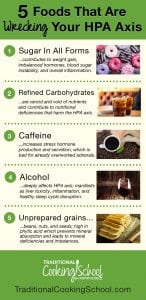
First, what exactly is the HPA axis? And, why is it such a big deal?
The hypothalamus, pituitary gland, and adrenal glands make up a complex system called the hypothalamic-pituitary-adrenal loop (a.k.a. HPA axis). The central nervous system and endocrine system connect via this HPA axis, working together to regulate stress response and hormone balance.
These 4 tiny organs produce hormones that regulate everything from our blood pressure and libido to our metabolism and stress response. These hormones include:
- cortisol and adrenaline — the main stress response hormones, involved in “fight or flight”
- aldosterone — the hormone that regulates blood pressure
- oxytocin — the hormone responsible for the mother-baby bond, body temperature, and sleep cycles
- prolactin — stimulates breast milk production
- and many more!
So, you can imagine how you might feel if the HPA axis wasn’t producing or regulating these hormones like it should!
When chronic stress occurs in an individual, the HPA axis continues to release hormones on an accelerated basis. But after time, the overproduction of these hormones leaves the glands of the HPA axis desensitized and they stop recognizing signals to stop producing hormones. The negative feedback loop is no longer functioning as it should and HPA axis dysfunction becomes the norm.
The idea of adrenal fatigue has become popular in natural and alternative health world in recent years. But while many alternative practitioners are focusing on the adrenal glands being fatigued as a result of chronic stress, that is only one part of the equation. It is actually the dysfunction of the entire HPA axis that is creating the symptoms, not simply a dysfunction in the adrenal glands alone. It is the dysfunction of the feedback loop of the HPA axis that ultimately creates the symptoms that people now associate with adrenal fatigue. (Source.)
Foods That Are Wrecking Your HPA Axis
Remember above, where I said that perhaps over three-fourths of Americans are living with (or trying to heal) the symptoms of HPA axis dysfunction?
If that’s you, I hope you’ve considered the role that your diet has in keeping your HPA axis healthy or not.
There are nourishing foods which should be eaten liberally in order to prevent or heal this storm of hormone imbalance. These are mineral-rich foods such as bone broth, sea vegetables, high-quality salt, and pastured animal proteins and fats. (Read about all 5 foods that nourish the HPA axis.)
And then, there are the foods that are wrecking your HPA axis…
These foods should be eliminated from your diet because they are causing harm to your body, prohibiting it from healing, and denying it the nutrients it needs to regain health and vitality.
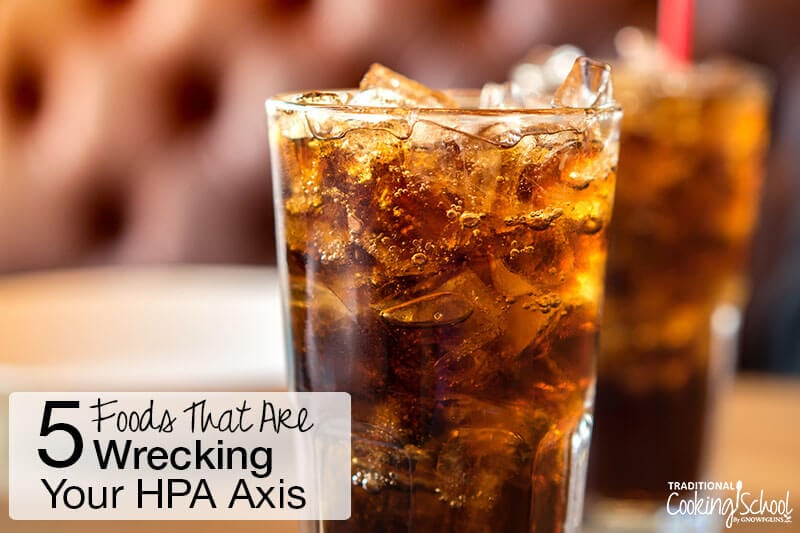
#1 — Sugar In All Forms
Of all the foods that are contributing to our society’s overall declining health, sugar tops the list. From imbalanced hormones and weight gain to inflammation and immune suppression, sugar is at the root of so many health problems…
Which is why, if you’re trying to heal your HPA axis, you must cut all forms of sugar out of your diet completely — white sugar (even organic!), high fructose corn syrup, corn syrup, whole sweeteners (honey, maple syrup, and coconut sugar), and even high-sugar fruits such as bananas, dates, mangoes, and grapes, and all fruit juices.
The health of the HPA axis depends on blood sugar stability. When you consume sugary, sweet foods, your blood sugar rises, signaling to your pancreas to release insulin to bring the blood sugar back to normal. This is a healthy and natural response. Unfortunately, most people suffering from HPA axis dysfunction are in a perpetual cycle of craving and then eating sweets.
Their blood sugar is like a scary rollercoaster ride, constantly spiking and dropping. So, not only is the pancreas always secreting insulin (which leads to insulin resistance), the HPA axis perceives this blood sugar imbalance as a threat and constantly secretes cortisol — because cortisol and insulin are both involved in blood sugar balance.
Over time, the HPA axis tires of secreting all this cortisol to help bring the blood sugar back to normal. (Learn the 11 signs of blood sugar imbalance.)
In addition to riding the never-ending blood sugar rollercoaster, sugar impacts your brain health, leads to weight gain and obesity, and contributes to liver toxicity. It’s best to eliminate it completely, especially if you find your cravings uncontrollable.
Action step: Eliminate all sources of sugar from your diet. Stevia and sugar alcohols — if tolerated and in moderation — are the only sweeteners that don’t cause disruption in blood sugar balance. Learn more about using stevia and about sugar alcohols. Read food labels and look for hidden sources of sugar, such as in tomato paste or store-bought dressing.
Fill up on foods that DO keep blood sugar balanced: grass-fed and pastured animal proteins and fats, coconut oil, and cooked vegetables like greens, peppers, squash, and cruciferous veggies.
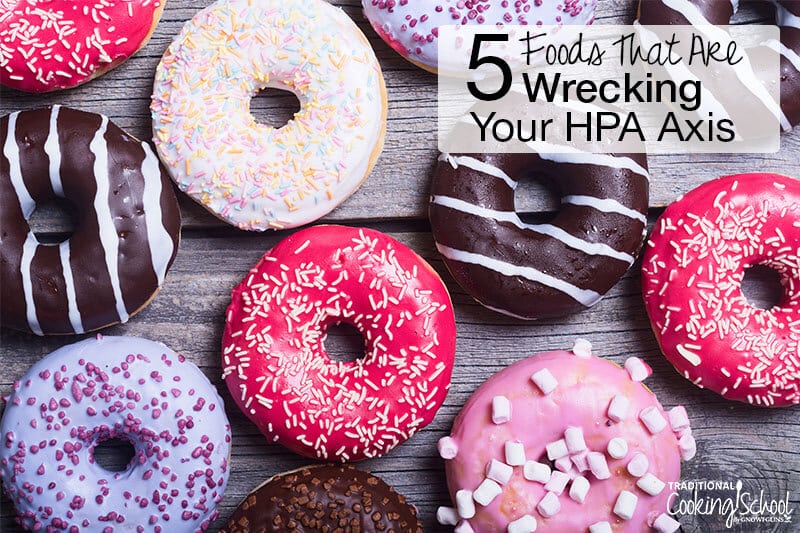
#2 — Refined & Processed Carbohydrates
Going along with sugar, refined and processed carbohydrates are also causing systemic inflammation, gut dysbiosis, and nutritional deficiencies. So, what are refined and processed carbohydrates? Usually, these are packaged, store-bought foods that come in a box, can, or bag and include:
- packaged bread goods: muffins, bagels, loaves, frozen or shelved rolls and breadsticks, canned biscuits
- boxed or bagged cereals, even “organic” ones that don’t have added sweeteners
- restaurant baked goods: bread, rolls, biscuits, donuts, etc.
- canned soups
- baking mixes
- pasta
- “quick” oats, potatoes, or rice
- packaged crackers
Even if they don’t have sugar (or high fructose corn syrup) on the ingredient label, these foods break down and turn into sugar in the body, leading to a rise in blood glucose. Then, it’s back on the blood sugar rollercoaster.
Additionally, these foods are highly processed and often rancid so that they are void of nutrients. This is why obese people living off processed foods are often malnourished (source).
Lack of nutrients plus their processing methods mean refined foods aren’t supplying your body with much-needed minerals, vitamins, and antioxidants. Rather, the body is starved of nourishment, which triggers the stress response over and over until these processed foods are removed from the diet and replaced with nutrient-dense foods that nourish the HPA axis.
Action step: Eliminate packaged, processed foods from your pantry, fridge, and freezer. Unless you can make them yourself, preferably from grain-free ingredients, just stay away from breads, muffins, crackers, etc. Make your own nourishing soups and “quick” oats and grain-free bread. Save money and eat out less or not at all!
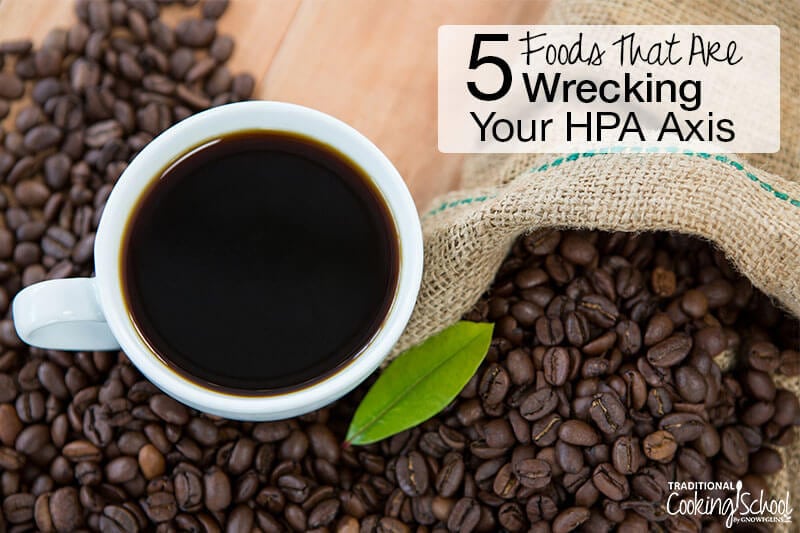
#3 — Caffeine
You probably knew this was coming, didn’t you? 😉
Many sufferers of HPA axis dysfunction have a steady caffeine habit because they need that boost in energy and concentration to wake up and function throughout the day. So, it’s a cup (or two) of coffee first thing in the morning. Then, around 3:00 to 4:00 p.m., it’s a coffee refill, some chocolate, a glass of tea, a soda, or a trip through the coffee shop drive-thru. Sound familiar?
Studies show that caffeine increases levels of stress hormones (such as cortisol and adrenaline) produced by the adrenal glands (source). So, if your adrenals are already over-burdened or out of whack, caffeine makes it worse. (Read more about caffeine and when you shouldn’t have it.)
Action step: Quit caffeine. From experience, the easiest and quickest way to do it is to rip off the band-aid and go “cold turkey”. You’ll likely experience some headaches, brain fog, and fatigue for a few days as your body has withdrawals. Switch to herbal tea, such as chamomile, to help facilitate detox and get you over the hump. Or, try one of these 15 energy-boosting drinks without caffeine.
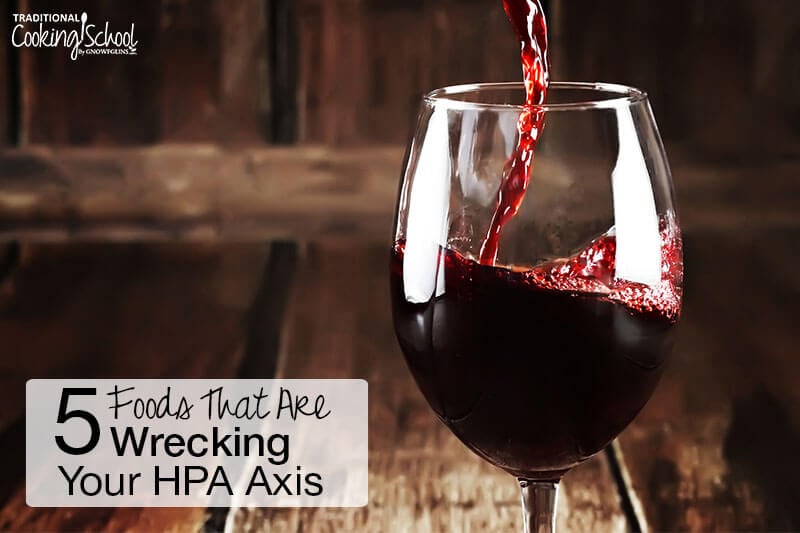
#4 — Alcohol
We typically think of alcohol has having a calming, relaxing effect — the opposite of caffeine. Wouldn’t that be good for someone who’s stressed out and anxious all the time?
Actually, just like sugar and caffeine, alcohol is very stressful on the adrenals. Alcohol might provide temporary relief from some symptoms of HPA axis dysfunction. However, the long-term effects of even moderate alcohol consumption (one glass of wine per day) on the HPA axis are far-reaching and extend to the liver, increased inflammation, and disruption of the Circadian rhythm.
Alcohol’s effects [on the entire endocrine system] induce hormonal disturbances that lead to profound and serious consequences at physiological and behavioral levels. These alcohol-induced hormonal dysregulations affect the entire body and can result in various disorders such as cardiovascular diseases, reproductive deficits, immune dysfunction, certain cancers, bone disease and psychological and behavioral disorders. (Source.)
Action step: Eliminate alcohol from your lifestyle. If you need a way to unwind and relax after a stressful day, try a hot Epsom salt bath, diffusing some soothing essential oils, going for a 30-minute walk, and/or doing some deep breathing or guided meditation.
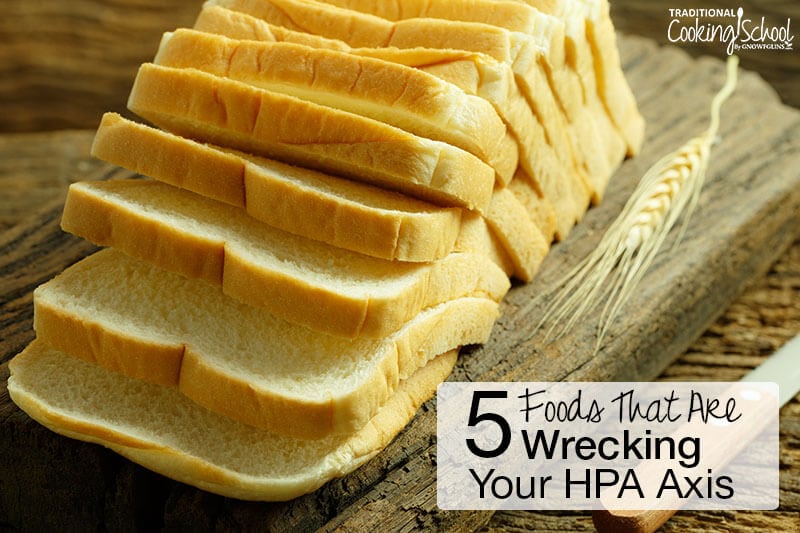
#5 — Improperly Prepared Grains, Beans, & Nuts
If you read 5 Foods That Nourish Your HPA Axis, you know that a healthy HPA axis is all about minerals, minerals, minerals! So, if you have HPA axis dysfunction, and you plan on eating grains, beans, and nuts, it’s extremely important that they’re properly prepared.
What does this mean?
Well, grains, beans, and nuts naturally contain a compound known as phytic acid. Phytic acid is actually enzyme inhibitor, meaning it allows the seed to hold on to all of the enzymes and minerals it already contains until germination time. Then, the enzymes are available to nourish the seedling until it grows roots and can be nourished with sunshine, water, and soil nutrients.
However, if we’re eating the grain/bean/nut, we don’t want to preserve its nutrients for germination… We want to unlock them for our own nourishment!
Monogastric animals including poultry and humans are unable to metabolize phytic acid due to the lack of sufficient level of phytate degrading enzymes activity in their digestive tract. (Source.)
Therefore, it’s important to properly prepare these foods to neutralize phytic acid and unlock all those wonderful minerals for ourselves! We do this by soaking, sprouting, or souring these foods.
Finally, it’s best to eliminate gluten from the diet when healing the HPA axis. Oftentimes, gluten sensitivity, intolerance, or celiac disease is a contributing factor to HPA axis dysfunction and gut dysbiosis.
Action step: Eliminate improperly prepared foods from your diet. Learn to properly prepare grains, beans, and nuts using traditional methods like soaking, sprouting, or souring. For even more information and instructional videos, check out our Fundamentals I & II eCourses, as well as our Sourdough eCourse!
How To Traditionally Prepare Grains, Beans, & Nuts
Here are some basic tutorials and recipes that use properly prepared grains, beans, and nuts:
- How To Soak And Cook Gluten-Free Grains
- Why And How To Soak And Dehydrate Nuts And Seeds
- How To Sprout Grains
- How To Sprout Chickpeas & Cook Them In The Instant Pot
- Where To Buy Soaked And Dehydrated Nuts And Seeds
- How To Soak & Cook Pinto Beans In The Instant Pot
- Cook Sprouted Brown Rice In The Instant Pot
Food Isn’t The Root Cause Of HPA Axis Dysfunction
While poor dietary choices certainly contribute to HPA axis dysfunction, food isn’t the root cause. It’s important to know this if you’re going to truly recover and feel like yourself again. You’ll definitely see a big difference in how you feel by eating those nourishing foods and avoiding these wrecking foods.
Most often, lifestyle choices or stressful events beyond your control begin the cascade of symptoms associated with HPA axis dysfunction. So, if you don’t make some serious lifestyle changes, you’re unlikely to experience deep and true healing.
In general, stress (or childhood trauma) is what got your adrenals into this mess. Therefore, a serious reduction in stress is what’s going to get you out. This includes…
- Prioritize sleep — Try to be in bed, sleeping no later than 10:00 p.m. and awake by 6:30 a.m. everyday. Your body will thrive in this rhythm.
- De-stress — Whatever form(s) stress takes for you, take every measure possible to reduce or eliminate it.
- Use adrenal-supporting essential oils.
- Get grounded — Spend time outside, connected to the earth and nature, barefooted if possible.
- Supplement — Magnesium, Methylated B-Vitamin Complex, Whole Foods Vitamin C, and mineral supplementation are all helpful.
Are you suffering with HPA axis dysfunction? Do you need to eliminate any of these foods from your diet?
More Adrenal Health Related Articles:
...without giving up the foods you love or spending all day in the kitchen!

2 free books:
Eat God's Way
Ditch the Standard American Diet, get healthier & happier, and save money on groceries...
We only recommend products and services we wholeheartedly endorse. This post may contain special links through which we earn a small commission if you make a purchase (though your price is the same).

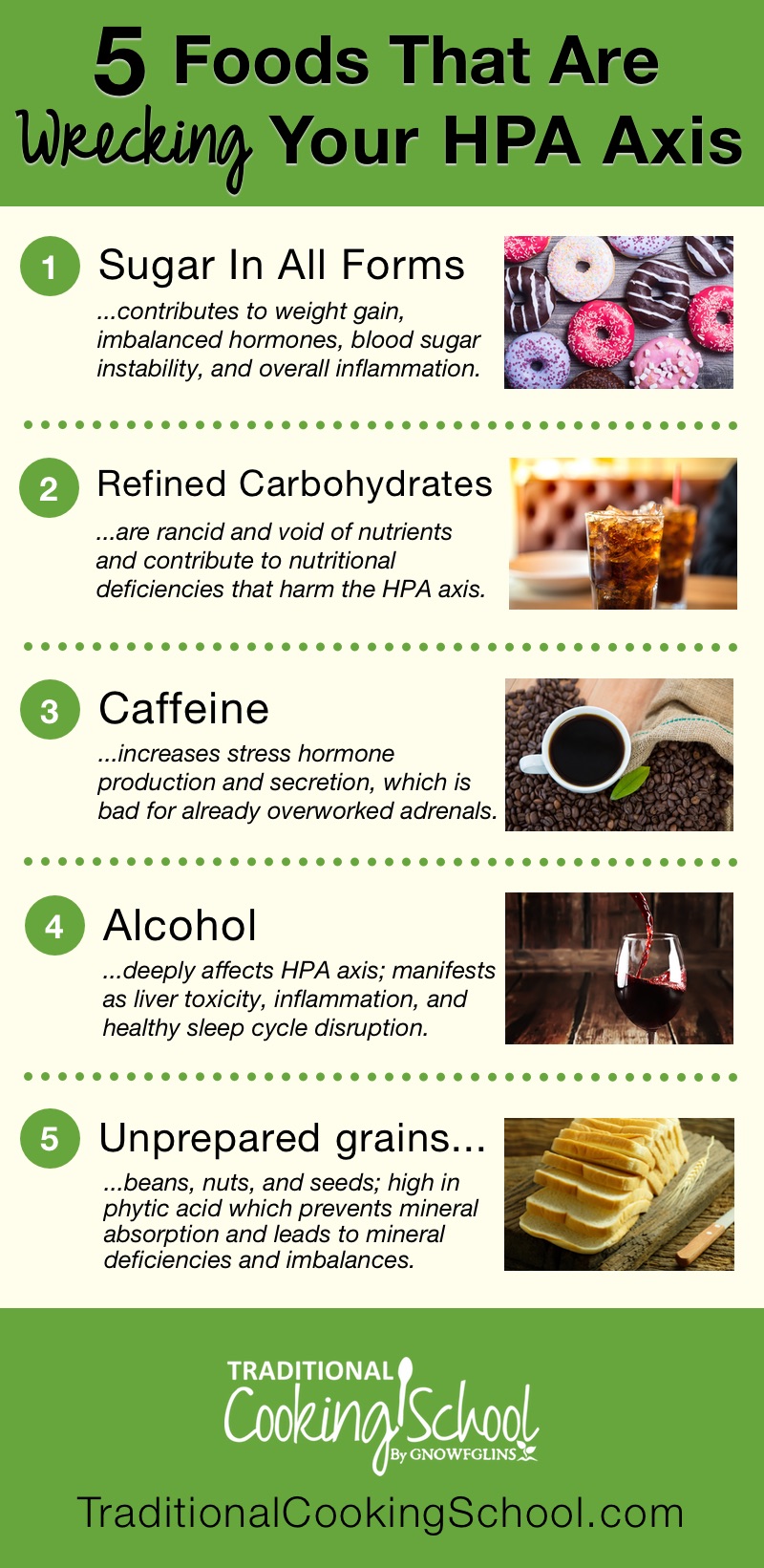

Thank you for this insightful information! It’s almost like bipolar-ish symptoms too. I say that because as we know the gut determines our moods and mind condition. This is one i am following!
Now that it’s cold, I’m looking for help on healing from hpa axis dysfunction with warmer foods, but I’m so confused. See, I feel terrible unless I eat raw foods, primarily fruit, even high sugar fruit. When I eat high carb raw foods, my energy starts to return but it does irritate my gut (usually, people just need an adjustment period). Quite alot of people have healed themselves from many ailments, including cancer, thyroid issues, candida overgrowth, and chronic fatigue on such a diet but you’re recommending we don’t consume high sugar fruits. If they hurt hpa axis function, why are so many people healing on the raw foods diet?